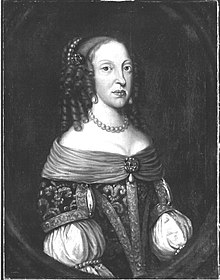Anna Sophia II, Abbess of Quedlinburg
| Anna Sophia II | |
|---|---|
 Anna Sophia around 1650 | |
| Princess-Abbess of Quedlinburg | |
| Reign | 1681–1683 |
| Predecessor | Anna Sophia I |
| Successor | Anna Dorothea |
| Born | 17 December 1638 Marburg, Landgraviate of Hesse-Darmstadt |
| Died | 13 December 1683 (aged 44) Quedlinburg Abbey |
| House | Hesse-Darmstadt |
| Father | George II, Landgrave of Hesse-Darmstadt |
| Mother | Sophia Eleonore of Saxony |
| Religion | Lutheranism |
Landgravine Anna Sophia of Hesse-Darmstadt (17 December 1638 – 13 December 1683) was a German noblewoman who reigned as a Princess-Abbess of Quedlinburg under the name Anna Sophia II.
Early life
[edit]Anna Sophia was a daughter of George II, Landgrave of Hesse-Darmstadt and Duchess Sophia Eleonore of Saxony. She was raised as a Lutheran, received a good education and grew up to be strictly religious.[1]
As writer
[edit]In 1655, at the age of 17, Anna Sophia entered the Quedlinburg Abbey.[1] In 1658, Anna Sophia published a book of spiritual meditations called Der treue Seelenfreund Christus Jesus. At first, Lutheran theologians regarded her book as suspect; they argued that the book equalized women with men, but it was later approved. Anna Sophia justified her work, as was standard in the 17th century, by saying that it was God's order. Being an abbess and a Lutheran at the same time, Anna Sophia defended her choice to remain unmarried in her book.[2] Her hymn Rede, liebster Jesu, rede was translated as Speak, O Lord, Thy Servant Heareth.[3]
As nun and abbess
[edit]Anna Sophia had a lapse of faith after her elder sister Landgravine Elisabeth Amalie of Hesse-Darmstadt converted to Roman Catholicism. She thought of leaving Quedlinburg to follow her sister's example but ultimately changed her mind.[4]
In her later years, Anna Sophia suffered from a "chronic cough". Nevertheless, she was elected to succeed Anna Sophia I as princess-abbess of Quedlinburg in 1681 under the name Anna Sophia II. The sick abbess selected Duchess Anna Dorothea of Saxe-Weimar as her coadjutor in 1683. Anna Sophia II succumbed to her illness (likely tuberculosis) later that year, after only two years of reign, and was succeeded by Anna Dorothea.
References
[edit]- ^ a b Stevenson, Jane (2005). Women Latin poets: language, gender, and authority, from antiquity to the eighteenth century. Oxford University Press. ISBN 0-19-818502-2.
- ^ Robin Bruce Barnes; Robert McCune Kingdon; Robert V. Schnucker, eds. (1998). Habent Sua Fata Libelli/Books Have Their Own Destiny: Essays in Honor of Robert V. Schnucker. Truman State University Press. ISBN 0-940474-59-X.
- ^ It is #230 in Evangelical Lutheran Hymnary, #589 in Lutheran Service Book, and #339 in Lutheran Worship. For the text of the translation, see the entry on hymnary.org.
- ^ Becker-Cantarin, Barbara (2004). Daphnis: Zeitschrift für Mittlere Deutsche Literatur und Kultur der Frühen Neuzeit. Band 31, No 3-4. Rodopi. ISBN 90-420-1631-0.

